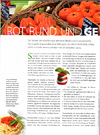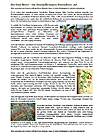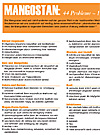Institut für Mangostan & natürliche Antioxidantien
Wissenschaftliche Studien und internationale Forschungsergebnisse | 76-90
76: J Nat Prod. 1997 May;60(5):519-24.
Related Articles,
Links
![]()
Evaluation of the antifungal activity of natural xanthones from Garcinia mangostana and their synthetic derivatives.
Gopalakrishnan G, Banumathi B, Suresh G.
Centre for Agrochemical Research, SPIC Science Foundations, Madras, India.
The antifungal activity of several xanthones isolated from the fruit hulls of Garcinia mangostana and some derivatives of mangostin against three phytopathogenic fungi, Fusarium oxysporum vasinfectum, Alternaria tenuis, and Dreschlera oryzae, has been evaluated. The natural xanthones showed good inhibitory activity against the three fungi. Substitution in the A and C rings has been shown to modify the bioactivities of the compounds.
Publication Types:
PMID: 9213587 [PubMed - indexed for MEDLINE]
77: Eur J Pharmacol. 1996 Oct 31;314(3):351-6.
Related Articles,
Links
![]()
Pharmacological properties of alpha-mangostin, a novel histamine H1 receptor antagonist.
Chairungsrilerd N, Furukawa K, Ohta T, Nozoe S, Ohizumi Y.
Department of Pharmaceutical Molecular Biology, Faculty of Pharmaceutical Sciences, Tohoku University, Sendai, Japan.
In the isolated rabbit thoracic aorta and guinea-pig trachea, alpha-mangostin inhibited histamine-induced contractions in a concentration-dependent manner in the presence or absence of cimetidine, a histamine H2 receptor antagonist. But KCl-, phenylephrine- or carbachol-induced contractions were not affected by alpha-mangostin. The concentration-contractile response curve for histamine was shifted to the right in a parallel manner by alpha-mangostin. In the presence of chlorpheniramine, a histamine H1 receptor antagonist, alpha-mangostin did not affect the relaxation of the rabbit aorta induced by histamine. In the guinea-pig trachea, alpha-mangostin had no effect on the relaxation induced by dimaprit, a histamine H2 receptor agonist. alpha-Mangostin caused a concentration-dependent inhibition of the binding of [3H]mepyramine, a specific histamine H1 receptor antagonist to rat aortic smooth muscle cells. Kinetic analysis of [3H]mepyramine binding indicated the competitive inhibition by alpha-mangostin. These results suggest that alpha-mangostin is a novel competitive histamine H1 receptor antagonist in smooth muscle cells.
Publication Types:
PMID: 8957258 [PubMed - indexed for MEDLINE]
78: Planta Med. 1996 Oct;62(5):471-2.
Related Articles,
Links
Histaminergic and serotonergic receptor blocking substances from the medicinal plant Garcinia mangostana.
Chairungsrilerd N, Furukawa K, Ohta T, Nozoe S, Ohizumi Y.
A crude methanolic extract of the fruit hull of Mangosteen, Garcinia mangostana L. inhibited the contractions of isolated thoracic rabbit aorta induced by histamine and serotonin. The extract of the fruit hull has been fractionated by silica gel chromatography, monitoring the pharmacological activity to give alpha- and gamma-mangostin. On the basis of pharmacological data, it is suggested that alpha-mangostin and gamma-mangostin are a histaminergic and a serotonergic receptor blocking agent, respectively.
Publication Types:
PMID: 8923814 [PubMed - indexed for MEDLINE]
79: J Pharm Pharmacol. 1996 Aug;48(8):861-5.
Related Articles,
Links
Antibacterial activity of xanthones from guttiferaeous plants against methicillin-resistant Staphylococcus aureus.
Iinuma M, Tosa H, Tanaka T, Asai F, Kobayashi Y, Shimano R, Miyauchi K.
Department of Pharmacognosy, Gifu Pharmaceutical University, Japan.
Extracts of Garcinia mangostana (Guttiferae) showing inhibitory effects against the growth of S. aureus NIHJ 209p were fractionated according to guidance obtained from bioassay and some of the components with activity against methicillin-resistant Staphylococcus aureus (MRSA) were characterized. One active isolate, alpha-mangostin, a xanthone derivative, had a minimum inhibitory concentration (MIC) of 1.57-12.5 micrograms mL-1. Other related xanthones were also examined to determine their anti-MRSA activity. Rubraxanthone, which was isolated from Garcinia dioica and has a structure similar to that of alpha-mangostin, had the highest activity against staphylococcal strains (MIC = 0.31-1.25 micrograms mL-1), an activity which was greater than that of the antibiotic vancomycin (3.13-6.25 micrograms mL-1). The inhibitory effect against strains of MRSA of two of the compounds when used in conjunction with other antibiotics was also studied. The anti-MRSA activity of alpha-mangostin was clearly increased by the presence of vancomycin; this behaviour was not observed for rubraxanthone. The strong in-vitro antibacterial activity of xanthone derivatives against both methicillin-resistant and methicillin-sensitive Staphylococcus aureus suggests the compounds might find wide pharmaceutical use.
Publication Types:
PMID: 8887739 [PubMed - indexed for MEDLINE]
80: Jpn J Pharmacol. 1996 Aug;71(4):337-40.
Related Articles,
Links
![]()
The mode of inhibitory action of alpha-mangostin, a novel inhibitor, on the sarcoplasmic reticulum Ca(2+)-pumping ATPase from rabbit skeletal muscle.
Furukawa K, Shibusawa K, Chairungsrilerd N, Ohta T, Nozoe S, Ohizumi Y.
Department of Pharmaceutical Molecular Biology, Faculty of Pharmaceutical Sciences, Tohoku University, Sendai, Japan.
alpha-Mangostin, the principal ingredient of the fruit hull of Garcinia mangostana, caused a concentration-dependent decrease in the activities of both Ca(2+)-ATPase and Ca(2+)-transport of the sarcoplasmic reticulum from rabbit skeletal muscle with an IC50 value of 5 microM. Neither Ca2+ release nor other enzyme activities were affected by alpha-mangostin. Kinetic analysis of the inhibitory effects of alpha-mangostin on Ca(2+)-ATPase suggests that the inhibition of the ATPase is a noncompetitive-type with respect to ATP or Ca2+. alpha-Mangostin may become a useful pharmacological tool for clarifying the physiological functions of Ca(2+)-pumping ATPase and sarcoplasmic reticulum.
Publication Types:
PMID: 8886932 [PubMed - indexed for MEDLINE]
81: Planta Med. 1996 Aug;62(4):381-2.
Related Articles,
Links
Active constituents against HIV-1 protease from Garcinia mangostana.
Chen SX, Wan M, Loh BN.
The ethanol extract of Garcinia mangostana L. (Guttiferae) showed potent inhibitory activity against HIV-1 protease. The activity-guided purification of the extract resulted in the isolation of two active, known compounds. The chemical structures of the isolated compounds were established by spectroscopic analyses as mangostin (IC50 = 5.12 +/- 0.41 microM) and gamma-mangostin (IC50 = 4.81 +/- 0.32 microM). The type of inhibition by both compounds is noncompetitive.
Publication Types:
PMID: 8792678 [PubMed - indexed for MEDLINE]
82: Free Radic Res. 1995 Aug;23(2):175-84.
Related Articles,
Links
Mangostin inhibits the oxidative modification of human low density lipoprotein.
Williams P, Ongsakul M, Proudfoot J, Croft K, Beilin L.
University of Western Australia, Department of Medicine, Royal Perth Hospital, Australia.
The oxidation of low density lipoprotein (LDL) may play an important role in atherosclerosis. We investigated the possible antioxidant effects of mangostin, isolated from Garcinia mangostana, on metal ion dependent (Cu2+) and independent (aqueous peroxyl radicals) oxidation of human LDL. Mangostin prolonged the lagtime to both metal ion dependent and independent oxidation of LDL in a dose dependent manner over 5 to 50 microM as monitored by the formation of conjugated dienes at 234 nm (P < 0.001). There was no significant effect of mangostin on the rate at which conjugated dienes were formed in the uninhibited phase of oxidation. Levels of thiobarbituric reactive substances (TBARS) generated in LDL were measured 4 and 24 hours after oxidation with 5 microM Cu2+ in the presence or absence of 50 microM or 100 microM mangostin. We observed an inhibition of TBARS formation with 100 microM mangostin at 4 hours (P = 0.027) but not at 24 hours (P = 0.163). Similar results were observed in the presence of 50 microM mangostin. Mangostin, at 100 microM, retarded the relative electrophoretic mobility of LDL at both 4 and 24 hours after Cu2+ induced oxidation. Mangostin (100 microM) significantly inhibited the consumption of alpha-tocopherol in the LDL during Cu2+ initiated oxidation over a 75 minute period (P < 0.001). From these results, we conclude that mangostin is acting as a free radical scavenger to protect the LDL from oxidative damage in this in vitro system.
PMID: 7581813 [PubMed - indexed for MEDLINE]
83: Southeast Asian J Trop Med Public Health. 1995;26 Suppl 1:306-10.
Related Articles,
Links
Study of genotoxic effects of antidiarrheal medicinal herbs on human cells in vitro.
Settheetham W, Ishida T.
Department of Physiology, Faculty of Medicine, Srinakharinwirot University, Bangkok, Thailand.
The use of medicinal herbs has been a common practice in Asia but their genotoxic properties are little known. In the present study, genotoxic effects of three antidiarrheal herbs, guava leaf, mangosteen peel and pomegranate peel, were examined using established human cell lines, Raji and P3HR-1. Cells were treated with boiled-water extract of the herbs at various concentrations for 24 and 48 hours in vitro. Cell growth and viability were dose dependently reduced. No apparent chromosomal aberrations were induced by the treatment. Administration of pomegranate extract induced apoptotic DNA fragmentation. This genotoxicity test system is simple and convenient for the primary screening.
Publication Types:
PMID: 8629131 [PubMed - indexed for MEDLINE]
84: Tree Physiol. 1994 Mar;14(3):263-74.
Related Articles,
Links
![]()
Influence of irradiance on photosynthesis, morphology and growth of mangosteen (Garcinia mangostana L.) seedlings.
Wiebel J, Chacko EK, Downton WJ, Lüdders P.
CSIRO, Division of Horticulture, PMB 44, Winnellie, N.T. 0821, Australia.
The influence of shading intensity on growth, morphology and leaf gas exchange of mangosteen (Garcinia mangostana L.) seedlings was investigated over a 2-year period. Diurnal gas exchange studies revealed significantly higher carbon gain for leaves grown in 20 or 50% shade compared to leaves grown in 80% shade. Seedlings grown in 20 or 50% shade accumulated significantly more dry weight than seedlings grown in 80% shade during the 2-year study period. Seedlings grown in decreased shade showed decreased leaf size, increased leaf thickness, lower specific leaf area (SLA) and higher stomatal frequency. Less shaded seedlings also allocated relatively more dry matter to roots than shaded seedlings and exhibited a significant reduction in leaf area relative to total plant dry weight (leaf area ratio). Increased leaf number, enhanced branching and shorter internodes resulted in a more compact appearance of less shaded seedlings. Irrespective of light conditions, mangosteen seedlings exhibited inherently slow growth because of low photosynthetic rates per unit leaf area, low SLA, low leaf area ratios and inefficient root systems.
PMID: 14967701 [PubMed - as supplied by publisher]
85: Tree Physiol. 1993 Jul;13(1):55-69.
Related Articles,
Links
![]()
Gas exchange characteristics of mangosteen (Garcinia mangostana L.) leaves.
Wiebel J, Eamus D, Chacko EK, Downton WJ, Lüdders P.
CSIRO, Division of Horticulture, Private Mail Bag 44, Winnellie, NT 0821, Australia.
Gas exchange responses of mangosteen (Garcinia mangostana L.) leaves to photosynthetic photon flux density (PPFD), internal CO(2) concentration (C(i)), leaf-air vapor pressure deficit (VPD), leaf temperature (T(l)) and time of day were investigated in plants grown in three shade treatments. Maximal photosynthetic rate (P(n(max))) per unit leaf area at light saturation did not differ significantly among plants grown in the different shade treatments despite significant morphological differences. Light compensation point (9-15 micro mol m(-2) s(-1)) and quantum yield (0.022-0.023) did not differ significantly among treatments, whereas light saturation point was significantly higher for leaves grown in 20% shade than for leaves grown in 50 or 80% shade (951, 645 and 555 micro mol m(-2) s(-1), respectively). Shade treatments significantly affected assimilation responses to varying CO(2) concentrations. At CO(2) concentrations between 600 and 1000 micro mol mol(-1), leaves from the 20% shade treatment recorded higher P(n) (6.44 micro mol m(-2) s(-1)) than leaves from the 80% shade treatment (4.57 micro mol m(-2) s(-1)). Stomatal conductance (g(s)) decreased with increasing CO(2) concentrations. Vapor pressure deficits higher than 2.5 kPa significantly decreased P(n) and g(s), whereas P(n) remained steady over a 24-33 degrees C temperature range in leaves in 80% shade and over a 27-36 degrees C range in leaves in 20 and 50% shade. Highest carbon gain during a 12-hour photoperiod was observed for leaves grown in 50% shade. The results imply that mangosteen is a shade-tolerant, lower canopy tree adapted to humid tropical lowlands. Providing low VPD in the nursery may result in maximal growth. However leaves of seedlings grown in 50 or 20% shade tolerated high VPD and temperatures better than leaves of seedlings grown in 80% shade, indicating some adaptability to the seasonally wet and dry tropics of northern Australia.
PMID: 14969901 [PubMed - as supplied by publisher]
86: Phytochemistry. 1992 Nov;31(11):3711-3.
Related Articles,
Links
![]()
Inhibition of wheat embryo calcium-dependent protein kinase and other kinases by mangostin and gamma-mangostin.
Jinsart W, Ternai B, Buddhasukh D, Polya GM.
Department of Chemistry, La Trobe University, Bundoora, Victoria, Australia.
The hull of the fruit of the mangosteen tree (Garcinia mangostana) contains four inhibitors of plant Ca(2+)-dependent protein kinase. Two of these inhibitors have been purified and identified as the xanthones 1,3,6-trihydroxy-7-methoxy-2,8-bis(3-methyl-2-butenyl)-9H- xanthen-9-one (mangostin) and 1,3,6,7-tetrahydroxy-2,8-bis(3-methyl-2-butenyl)- 9H-xanthen-9-one (gamma-mangostin). Both xanthones also inhibit avian myosin light chain kinase and rat liver cyclic AMP-dependent protein kinase. This is the first report of inhibition of plant and animal second messenger-regulated protein kinases by plant-derived xanthones.
Publication Types:
PMID: 1368866 [PubMed - indexed for MEDLINE]
87: Planta Med. 1983 May;48(5):59-60.
Related Articles,
Links
Antimicrobial Activities of Garcinia mangostana.
Sundaram BM, Gopalakrishnan C, Subramanian S, Shankaranarayanan D, Kameswaran L.
Department of Microbiology and P.G. Institute of Basic Medical Sciences, Taramani, India.
PMID: 17404946 [PubMed - in process]
88: Planta Med. 1983 May;48(1):59-60.
Related Articles,
Links
Antimicrobial activities of Garcinia mangostana.
Sundaram BM, Gopalakrishnan C, Subramanian S, Shankaranarayanan D, Kameswaran L.
PMID: 6611746 [PubMed - indexed for MEDLINE]
89: Indian J Exp Biol. 1980 Aug;18(8):843-6.
Related Articles,
Links
Effect of mangostin, a xanthone from Garcinia mangostana Linn. in immunopathological & inflammatory reactions.
Gopalakrishnan C, Shankaranarayanan D, Kameswaran L, Nazimudeen SK.
PMID: 7461736 [PubMed - indexed for MEDLINE]
90: Arch Int Pharmacodyn Ther. 1979 Jun;239(2):257-69.
Related Articles,
Links
Pharmacological profile of mangostin and its derivatives.
Shankaranarayan D, Gopalakrishnan C, Kameswaran L.
Mangostin (M), a naturally occurring xanthone in the rinds of the fruits of Garcinia mangostana Linn. (Guttiferae) and its derivatives such as 3-0-methyl mangostin (MM), 3,6-di-O-methyl mangostin (DM), 1-isomangostin (IM), mangostin triacetate (MT), mangostin 3,6-di-O-(tetra acetyl) glucoside (MTG) and mangostin-6,6-di-O-glucoside (MOG) were screened for various pharmacological effects in experimental animals. With the exception of DM all the test compounds produced CNS depression characterised by ptosis, sedation, decreased motor activity, potentiation of pentobarbital sleeping time and ether anaesthesia in mice and rats. None of the compounds exhibited analgesic, antipyretic and anticonvulsant effects. With the exception of MOG, none of the test compounds produced significant effects on the cardiovascular system of frogs and dogs. MOG produced myocardial stimulation and a rise in blood pressure which was partially blocked by propranolol. M, IM and MT produced pronounced antiinflammatory activity both by intraperitoneal and oral routes in rats as tested by carrageenininduced hind paw oedema, cotton pellet implantation and granuloma pouch techniques. Antiinflammatory activity for M, IM and MT was observed even in bilaterally adrenalectomised rats. M, IM and MT did not produce any mast cell membrane stabilising effect and the degranulation effect of polymyxin B, diazoxide and Triton X-100 on rat peritoneal mast cells in vitro was not prevented. M, IM and MT did not alter the prothrombin time of albino rats. M alone produced significant antiulcer activity in rats.
PMID: 314790 [PubMed - indexed for MEDLINE]




















